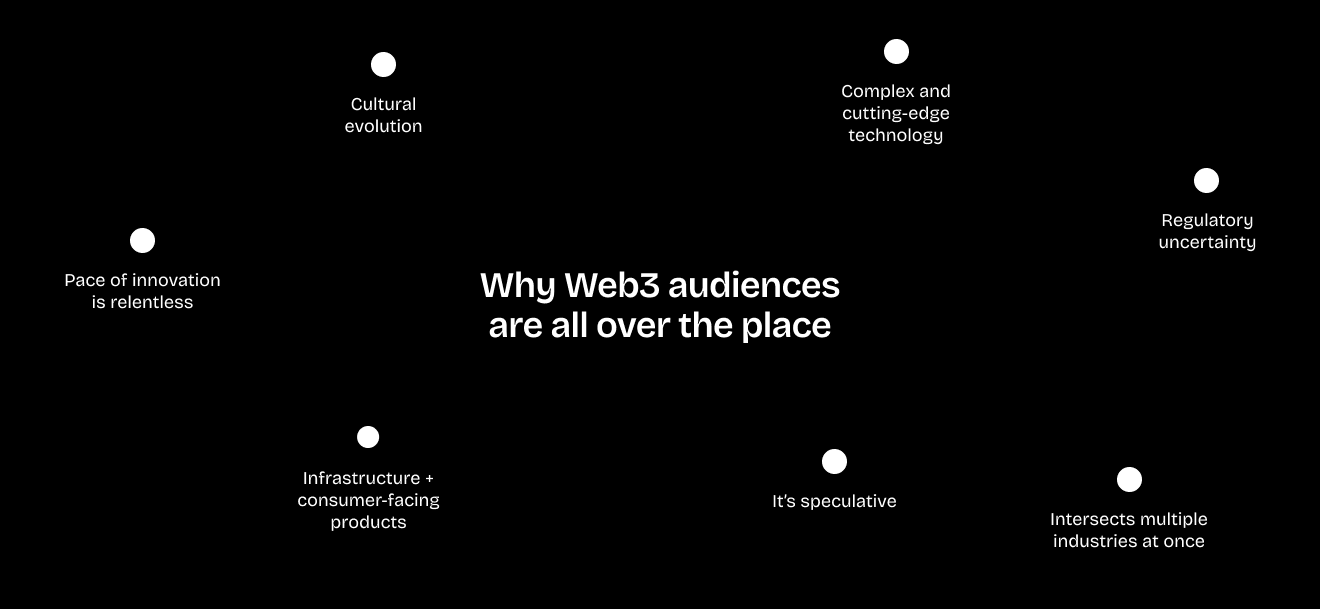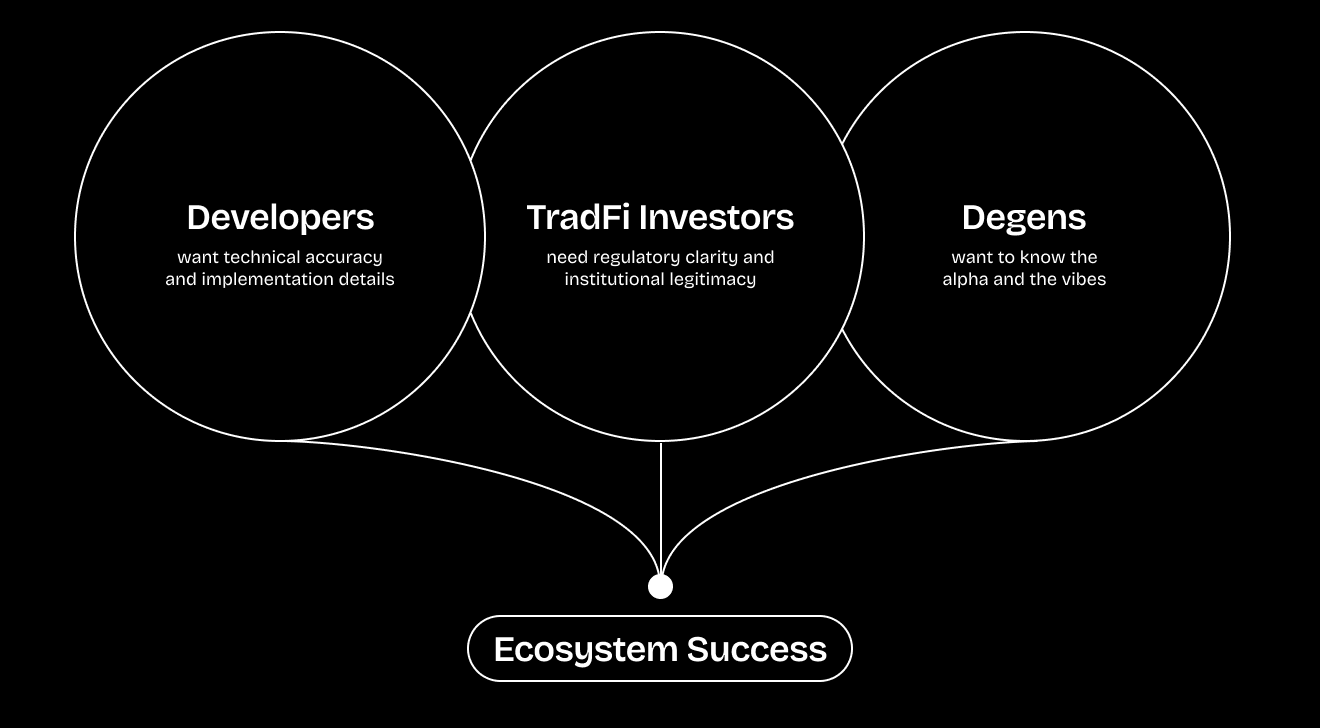Related Articles



One of the first questions I ask any new project is: who do you want using your product? Who needs to know about it?
Too often in Web3, the focus is on shipping—build the product, put out some content, hope for the best. But effective content marketing guides people through a specific journey: awareness, understanding, relevance, and adoption. And that journey looks completely different for a developer versus a TradFi investor versus a degen. Skip the audience work, and you end up shouting into the void with content that speaks to no one.
So, how do you actually figure out who your audiences are? It starts with a concept Web3 knows well: KYC.
In Web3, KYC isn't just a compliance thing. It's a content marketing imperative. Know Your Customer, Know Your Audience.
Before I was doing content marketing, I spent years doing actual KYC as an AML analyst and banker. That work taught me how to build detailed profiles, understand what motivates different people, and spot patterns in behavior. I'm not talking about collecting DOBs and home addresses. I'm talking about understanding demographics, occupation, career level, and pain points. The insights that actually help you tailor your messaging. Turns out, the KYC research skills are the same—I've just taken my internet sleuthing from compliance to content.

I really discovered just how fragmented Web3 audiences are while working on content marketing for CoinDesk's Consensus conference. Consensus is crypto’s big tent event, with programming for developers, degens, creators, institutional investors, VCs, founders, startups, regulators, and more. This experience showed me just how wide and disparate the crypto audience really is—people with completely different backgrounds, knowledge levels, and goals, all in one place
So why is the Web3 audience so all over the place? Here's my take:
All of this creates an audience landscape unlike anything in traditional tech or finance. And it's precisely why the "just create content and ship it" approach fails so spectacularly.

I don't talk to developers the same way I talk to TradFi investors, the same way I talk to degens. And if you're using the same content for all three, you're wasting everyone's time.
Developers want technical accuracy and implementation details:
TradFi investors need regulatory clarity and institutional legitimacy:
Degens want to know the alpha and the vibes:
This isn't just about tone or channel selection. It's about fundamentally different information needs, different levels of prior knowledge, and different decision-making criteria. And here's what makes Web3 especially tricky: you often need to reach all of these audiences simultaneously because they all play a role in your ecosystem's success.
You can't Google what doesn't exist yet. So when you're creating foundational content about emerging tech, you're not just marketing to these audiences. You're educating them, defining the category for them, and shaping how they'll understand and talk about your product forever. Get the audience wrong, and you're not just creating ineffective marketing. You're literally building the wrong knowledge base for your ecosystem.
In traditional tech, the lines are clear: product marketing defines what the product is, and content marketing promotes it. In Web3, those lines don't exist.
Your content shapes how people understand what your product even is. When you're building something new without an established category, your educational content becomes inseparable from your product positioning. The way you explain your protocol, the metaphors you use, the complexity level you choose—all of this defines the product in your audience's mind.
This is why audience research has to inform your product decisions, not just your messaging. When you understand who you're building for, you might realize:
In Web3, content marketing and product marketing go hand in hand. You can't build a product people understand if you don't know who those people are. And you can't market effectively if your content doesn't align with how your audience actually thinks about what you've built.

For me, Consensus was like the final boss of crypto audience segmentation. So many different types of people, so many event offerings, all under one roof.
So what did I do? I broke down the audience into segments and performed extensive research on each one:
From there, I created detailed audience personas. These weren't just demographic profiles. They were frameworks for understanding how different people think, what motivates them, and what would actually get them to pay attention.
Then we used those personas to create tailored messaging and identify specific channels for each audience. An ad on a finance podcast for the TradFi audience. A mention in a dev newsletter for developers. Different messages, targeting each persona's specific pain points and goals. The objective wasn't just reach. It was resonance.
This kind of work takes time. It requires actual research, not assumptions. And it demands that you think strategically about not just what you want to say, but who needs to hear it and why they should care.
Most projects skip this step entirely. They create one message and blast it everywhere, hoping something sticks. And then they wonder why their content isn't working.
Here's what I didn't cover in this article: the full persona templates, the pain point mapping frameworks, how to operationalize this across channels, how to measure and iterate, and how to align your entire team around these insights. That work is deep, and it's ongoing.
But here's what you should take away: if you're creating Web3 content without knowing exactly who you're talking to, you're building on sand. The technology is too complex, the audiences are too fragmented, and the stakes are too high to guess.
Good audience research isn't a nice-to-have. It's the foundation of everything else you do. Your messaging, your channels, your product decisions, your positioning—all of it flows from understanding who you're building for and what they actually need.
Most projects don't have the time or expertise to do this level of research in-house. And honestly, it shouldn't be an afterthought that you try to squeeze in between product launches.
If you're ready to stop guessing and start building content that works, let's talk. At Distractive, we specialize in Web3 content marketing backed by serious audience research.
Build the future of Web3 with people who get you. No suits required. Memes encouraged.